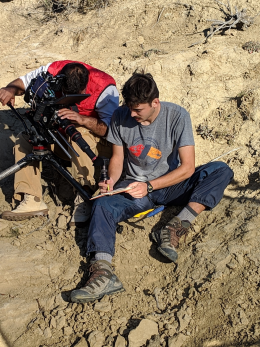
Three Colorado College alumni - one of whom won CC's Spirit of Adventure Award in 2017 - are part of a team that announced the discovery near Colorado Springs of a remarkable collection of fossils that reveal in striking detail how the world and life recovered after the catastrophic asteroid impact that wiped out the dinosaurs 66 million years ago.
Ian Miller '99, curator of paleobotany and director of earth and space sciences at the Denver Museum of Nature & Science, Gussie Maccracken '11, a paleontology Ph.D. candidate in the Department of Entomology at the University of Maryland College Park, and Benjamin Lloyd '19, a recent Colorado College graduate and currently the paraprofessional in CC's Department of Geology, were involved in the research and writing of the article published in the Oct. 24 issue of Science magazine.
"It was an incredible experience working with such a prestigious group of scientists, including friends and alumni from Colorado College, says Maccracken. "Between Miller and Lloyd, we span 20 years of CC grads."
Described in a peer-reviewed paper titled "Exceptional continental record of biotic recovery after the Cretaceous-Paleogene mass extinction," the find - thousands of exceptionally preserved animal and plant fossils from the critical first million years after the catastrophe - shines a revelatory light on how life emerged from Earth's darkest hour.
The new and exceptional record from the first million years after the asteroid impact combines plants, animals and precise dates - a paleontological trifecta - painting a portrait of the emergence of the modern world.
In addition to the paper published in Science magazine, the story of the discovery is the subject of a new NOVA production, "Rise of the Mammals," that will stream online beginning Oct. 24 across PBS platforms and mobile apps (https://www.pbs.org/nova/video/rise-of-the-mammals/) and will be broadcast nationally by PBS on Oct. 30.
As explained in the documentary and an accompanying exhibit, "After the Asteroid: Earth's Comeback Story," which opens Oct. 24 at the Denver Museum of Nature & Science, a moment of serendipity pointed the way to the fossils, which had been hiding in plain sight.
Tyler Lyson, curator of vertebrate paleontology at the Denver Museum of Nature & Science, is the lead author, along with Miller, who received CC's Spirit of Adventure Award two years ago, of the article in Science magazine. The two led the team of 16 authors, which include CC alumni Maccracken and Lloyd, on the paper.
Although Lyson had avidly searched for fossils, the remains of vertebrates after the asteroid impact had largely eluded him - until 2016. That summer, inspired by a fossil that had been sitting in a drawer and fossil-hunting techniques used by some of his South African colleagues, he stopped looking for glinting bits of bone in the Denver Basin and instead zeroed in on egg-shaped rocks called concretions.
Cracking open the concretions, Lyson and Miller found wonders. Inside were skulls of mammals from the early generations of survivors of the mass extinction. Finding even a single skull from this era is a coup. In fact, most of what is understood from this era is based on tiny fragments of fossils, such as pieces of mammal teeth.
"You could go your entire career and not find a skull from this period. That's how rare they are," says Miller.
Yet he and Lyson found four in a single day and more than a dozen in a week once the fossil-searching code was cracked. "It was crazy the way it happened," Miller says. So far, they've found fossils from at least 16 different species of mammal.
The paleontological "trifecta" at the site made use of the expertise of the Colorado College contingent. Maccracken is a paleoecologist with expertise in ancient plant-insect interactions, who also worked on the paleobotany at the site.
Lloyd had a summer internship in 2017 excavating dinosaur fossils in North Dakota before an internship at the Denver Museum of Nature & Science with Miller following year. Lloyd's area of concentration at the site outside Colorado Springs was paleobotany, in which he looked for fossils of leaves and other plant material - vital to reconstructing the environment at the time.
"It was so cool working with CC people," he says. "They were really helpful and understood the knowledge base that I had. They knew where I was coming from."
The Denver Basin site also adds powerful evidence to the idea that the recovery and evolution of plants and animals were intricately linked after the asteroid impact. Combining the fossil plant record with the discovery of the fossil mammals has allowed the team to link millennia-long warming spells to global events, including massive amounts of volcanism on the Indian subcontinent. These events may have shaped the ecosystems half a world away.


